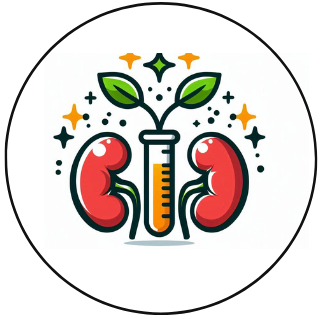Recognizing the Signs of Kidney Disease Flare-Ups: What You Need to Know
Living with kidney disease means staying aware of how your body is feeling and recognizing when things aren’t quite right. While managing the condition daily is crucial, sometimes flare-ups can happen, and they can sneak up on you if you’re not paying attention. In this blog post, we’ll go over the common signs of kidney disease flare-ups, what to do when they happen, and how to manage your health proactively. Plus, I’ll suggest some helpful tools and products (with affiliate links!) that can support your kidney health.
What is a Kidney Disease Flare-Up?
A flare-up refers to a sudden worsening of symptoms or a spike in the severity of your condition. For those with chronic kidney disease (CKD), flare-ups can be triggered by various factors like dehydration, infections, diet changes, or even stress. Recognizing a flare-up early is key to preventing further damage to your kidneys and getting the medical attention you need.
So, what should you look for?
1. Swelling (Edema)
One of the first and most common signs of a kidney disease flare-up is swelling, especially in your feet, ankles, legs, and sometimes your hands and face. This happens because your kidneys aren’t filtering fluids properly, causing them to build up in your body.
What to do: Monitor your swelling closely. If it gets worse, especially with weight gain, contact your healthcare provider. Keeping your legs elevated and reducing your sodium intake can help reduce swelling.
Consider using a blood pressure monitor to keep track of your blood pressure, as swelling often accompanies high blood pressure. I recommend the Omron Blood Pressure Monitor, which is easy to use and highly accurate.
2. Changes in Urine
Your urine says a lot about your kidney health. Pay attention to these changes during a flare-up:
- Foamy or bubbly urine: This can be a sign of protein leaking into your urine, a condition known as proteinuria.
- Dark-colored or bloody urine: This could indicate kidney damage or infection.
- Less frequent urination: If you’re not going as often as usual, it could mean your kidneys are retaining fluid, which is dangerous.
- Pain or burning when urinating: This may signal a urinary tract infection (UTI), which is more common in people with kidney disease.
What to do: If you notice any of these changes, contact your doctor immediately. Keeping track of your fluid intake and output is important, especially during a flare-up.
Use a hydration tracker like the Hydr-8 Daily Hydration Tracker Water Bottle to ensure you’re getting the right amount of fluids, which is crucial for managing kidney disease.
3. Fatigue and Weakness
Feeling extra tired and weak can be a sign of worsening kidney function. Your kidneys help balance electrolytes, remove toxins, and create hormones that regulate energy levels. During a flare-up, your body may struggle with this, leaving you feeling fatigued even after plenty of rest.
What to do: Make sure you’re eating kidney-friendly foods rich in iron and energy-boosting nutrients. Rest when needed but try to stay lightly active, as gentle movement can help improve circulation and energy levels.
Consider taking a daily kidney health supplement. Something like the Renal Support Nutritional Supplement can help provide the necessary nutrients to boost your energy levels without putting strain on your kidneys.
4. Shortness of Breath
When your kidneys can’t properly filter fluids, that excess fluid can build up in your lungs, making it difficult to breathe. This condition is known as pulmonary edema and can become dangerous if left unchecked.
What to do: If you’re experiencing shortness of breath, especially when lying down, it’s important to seek medical attention immediately. This could indicate a more serious kidney problem.
Keep an eye on your oxygen levels using a pulse oximeter like the Zacurate Pro Series Pulse Oximeter. This device is small, affordable, and can help you monitor your oxygen levels at home.
5. High Blood Pressure
High blood pressure and kidney disease are closely linked. A sudden spike in blood pressure can be a sign of a flare-up. Since the kidneys help regulate blood pressure, any issues with them can cause your numbers to skyrocket.
What to do: Managing your blood pressure is essential for slowing the progression of kidney disease. If you notice your blood pressure rising consistently, it’s time to get in touch with your doctor.
Use the Omron Blood Pressure Monitor to track your blood pressure from home and share your readings with your doctor. Having reliable equipment to monitor your blood pressure can help you act quickly if things go wrong.
6. Nausea or Vomiting
When your kidneys aren’t functioning properly, waste and toxins can build up in your body, leading to nausea or vomiting. This is often a sign of uremia, a condition that occurs when waste products accumulate in the blood.
What to do: Staying hydrated and sticking to a low-sodium, low-protein diet can help ease these symptoms, but it’s important to speak with your doctor if nausea persists.
Keep a kidney-friendly meal plan on hand. Consider checking out Renal Diet Recipes Cookbooks, which offer easy-to-follow recipes that are both delicious and supportive of kidney health.
7. Itchy Skin
Kidneys help balance minerals and remove waste from the bloodstream. When they aren’t functioning well, excess minerals (such as calcium and phosphorus) can accumulate, leading to itchy skin. This can feel frustrating and uncomfortable, especially during flare-ups.
What to do: Speak to your doctor if your itching becomes severe, as it could be a sign of high phosphorus levels. Moisturizing your skin regularly can help soothe the itch.
Try using a hypoallergenic moisturizer like CeraVe Itch Relief Moisturizer, which is gentle and helps soothe irritated skin without harsh chemicals.
Managing Flare-Ups: Prevention and Preparation
While recognizing the signs of a flare-up is important, the best way to protect your kidneys is by preventing these flare-ups from happening in the first place. This includes:
- Sticking to a kidney-friendly diet: Low-sodium, low-potassium, and low-phosphorus diets help reduce strain on your kidneys.
- Staying hydrated: Drinking enough water (but not too much) can help your kidneys filter waste effectively.
- Monitoring your health: Regular check-ups, blood pressure monitoring, and keeping track of your symptoms can make a big difference.
Conclusion
Kidney disease flare-ups can be overwhelming, but recognizing the signs early can make a world of difference. Keeping an eye on changes in your body, from swelling to changes in urine and fatigue, is essential for catching flare-ups before they become more serious.
Be proactive about your kidney health, and don’t hesitate to use tools and products that can help you manage your condition. Remember, a small change like monitoring your blood pressure or drinking the right amount of water can make a huge difference in your long-term health.
Feel free to explore the helpful affiliate links above for products designed to support kidney health, and take steps today to manage your kidney disease with confidence!
Disclosure: Some of the links are affiliate links. Purchasing through one of these affiliate links adds no cost to you but may allow kidneyfreshfuel a small commission. This allows us to continue to bring you quality information.

